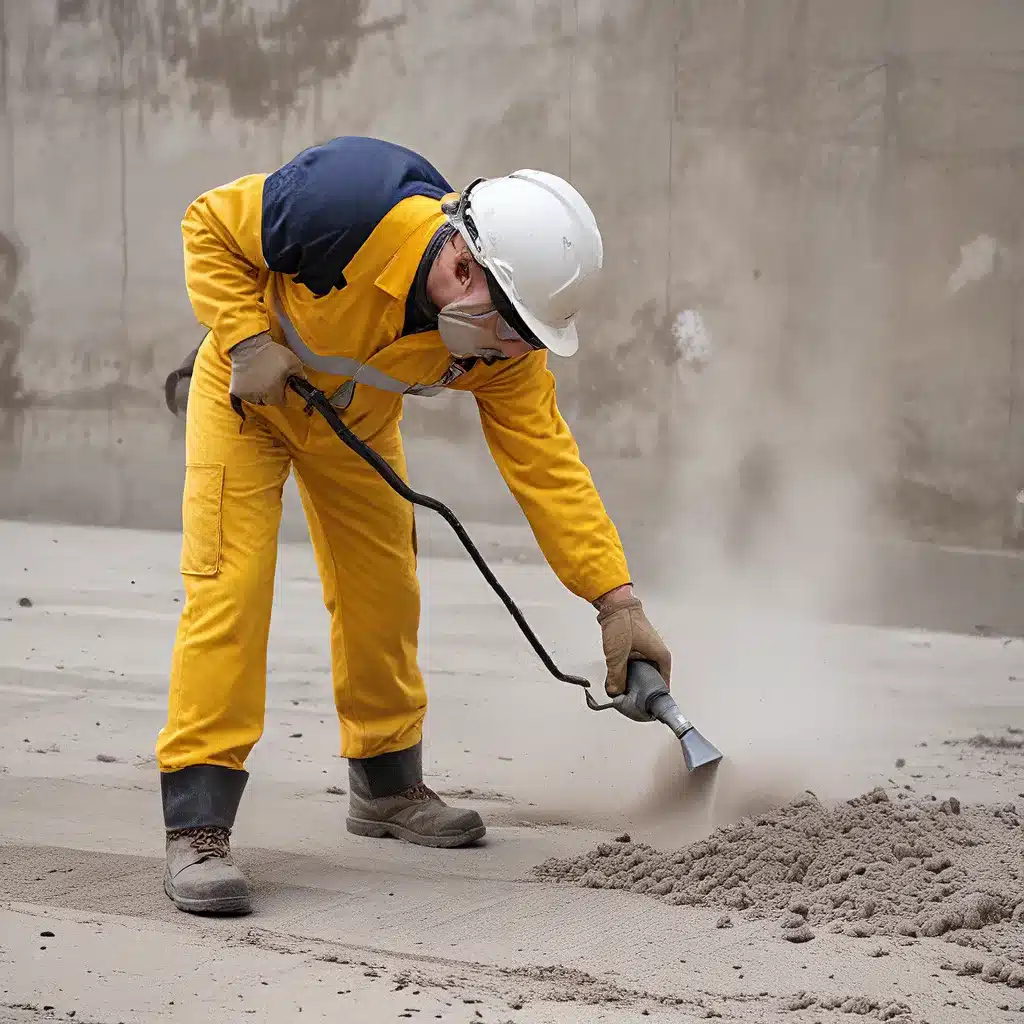
Concrete Dust – The Hidden Hazard Lurking on the Job Site
As I step onto the job site, the air is thick with the scent of freshly poured concrete. The hum of machinery and the clang of tools fill the air, but there’s another, more sinister element present – concrete dust. Invisible to the naked eye, this fine particulate matter can pose a serious threat to the health and safety of the dedicated workers who keep our concrete infrastructure strong and resilient.
OSHA’s guidance on crystalline silica paints a concerning picture. Exposure to this dust can lead to the development of silicosis, a debilitating lung disease that can leave workers struggling to breathe. And it’s not just silicosis we need to worry about – exposure to concrete dust has also been linked to lung cancer, kidney disease, and autoimmune disorders. The stakes couldn’t be higher, and as a company committed to the well-being of our employees, we simply can’t afford to ignore this pressing issue.
Recognizing the Dust Danger
Concrete dust may seem like a mundane part of the job, but make no mistake – it’s a formidable foe. This fine powder is created when concrete is cut, ground, or polished, and it can linger in the air long after the work is done. And it’s not just the concrete itself that poses a threat – the silica content in sand and other aggregates used in concrete can also contribute to the problem.
One of the trickiest things about concrete dust is that it’s not always easy to spot. Unlike the larger, visible particles that may settle on the ground, these microscopic specks can remain airborne for hours, just waiting to be breathed in by unsuspecting workers. And that’s where the real danger lies – with each inhalation, workers are potentially exposing themselves to a host of health hazards.
Tackling the Dust Head-On
So, what can we do to protect our workers from the perils of concrete dust? The answer lies in a comprehensive approach that combines engineering controls, administrative measures, and personal protective equipment (PPE). Cal/OSHA’s guidance on the hierarchy of controls provides a valuable framework for addressing this issue.
Engineering Controls: The First Line of Defense
The most effective way to combat concrete dust is to attack the problem at the source. By implementing engineering controls like local exhaust ventilation systems or wet cutting techniques, we can dramatically reduce the amount of dust that’s released into the air. These solutions not only protect workers, but they also help to keep the job site cleaner and more organized.
One of the key things to watch out for is the use of dry cutting or grinding methods. These processes can generate massive amounts of airborne dust, putting workers at risk. By switching to wet-cutting systems that use water to suppress the dust, we can significantly improve the air quality on the job site.
Administrative Controls: Minimizing Exposure
While engineering controls are the foundation of our dust mitigation strategy, administrative measures can also play a crucial role. By implementing policies and procedures that limit worker exposure, we can further enhance the safety of our job sites.
For example, we can establish strict work practices that minimize the generation of dust, such as limiting the use of power tools or scheduling dust-generating activities during off-peak hours. We can also provide comprehensive training to our employees, empowering them to recognize the signs of concrete dust exposure and take proactive steps to protect themselves.
Personal Protective Equipment: The Last Line of Defense
Even with robust engineering and administrative controls in place, there may still be instances where workers need to use PPE to safeguard their health. This could include respirators, coveralls, and other specialized gear designed to keep concrete dust at bay.
OSHA’s guidance on the Respirable Crystalline Silica Standard provides detailed information on the proper selection and use of PPE, including the importance of a comprehensive respirator protection program. By ensuring that our workers have access to the right equipment and are trained in its proper use, we can give them an additional layer of protection against the dangers of concrete dust.
Embracing a Culture of Safety
Ultimately, the key to mitigating concrete dust exposure is to foster a culture of safety on our job sites. This means that every member of our team, from the project managers to the entry-level workers, must be committed to prioritizing health and well-being above all else.
By leading by example and empowering our employees to speak up about safety concerns, we can create an environment where everyone feels empowered to take action. And when it comes to concrete dust, that could mean the difference between a healthy, thriving workforce and one that’s struggling to breathe.
The Concrete Solution: Protecting Our Most Valuable Asset
At Concrete Townsville, we understand that our employees are the lifeblood of our business. Their dedication, skill, and hard work are what allow us to deliver the high-quality concrete solutions our clients have come to expect. And that’s why we’re committed to doing everything in our power to protect their health and safety.
By implementing a comprehensive dust mitigation strategy that combines engineering controls, administrative measures, and personal protective equipment, we’re taking a proactive approach to addressing this crucial issue. And by fostering a culture of safety on our job sites, we’re empowering our workers to be active participants in their own well-being.
Concrete dust may be an invisible threat, but it’s one that we’re determined to vanquish. Because when it comes to the health and safety of our team, we simply won’t settle for anything less than the best. After all, our workers are the heart and soul of our company, and we owe it to them to do everything in our power to keep them safe.

